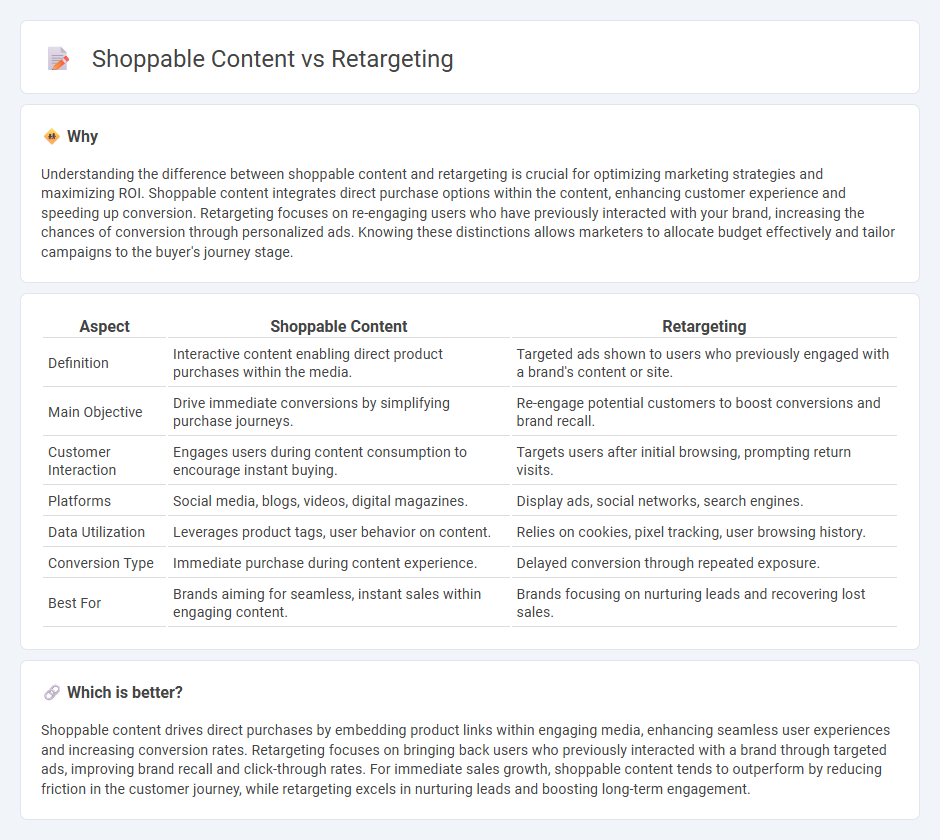
Shoppable content integrates products directly within engaging media, streamlining the customer journey by enabling immediate purchases without leaving the platform. Retargeting employs targeted ads to re-engage users who have previously interacted with a brand, boosting conversion rates through customized messaging. Explore the nuances of shoppable content and retargeting to optimize your marketing strategy.
Why it is important
Understanding the difference between shoppable content and retargeting is crucial for optimizing marketing strategies and maximizing ROI. Shoppable content integrates direct purchase options within the content, enhancing customer experience and speeding up conversion. Retargeting focuses on re-engaging users who have previously interacted with your brand, increasing the chances of conversion through personalized ads. Knowing these distinctions allows marketers to allocate budget effectively and tailor campaigns to the buyer's journey stage.
Comparison Table
| Aspect | Shoppable Content | Retargeting |
|---|---|---|
| Definition | Interactive content enabling direct product purchases within the media. | Targeted ads shown to users who previously engaged with a brand's content or site. |
| Main Objective | Drive immediate conversions by simplifying purchase journeys. | Re-engage potential customers to boost conversions and brand recall. |
| Customer Interaction | Engages users during content consumption to encourage instant buying. | Targets users after initial browsing, prompting return visits. |
| Platforms | Social media, blogs, videos, digital magazines. | Display ads, social networks, search engines. |
| Data Utilization | Leverages product tags, user behavior on content. | Relies on cookies, pixel tracking, user browsing history. |
| Conversion Type | Immediate purchase during content experience. | Delayed conversion through repeated exposure. |
| Best For | Brands aiming for seamless, instant sales within engaging content. | Brands focusing on nurturing leads and recovering lost sales. |
Which is better?
Shoppable content drives direct purchases by embedding product links within engaging media, enhancing seamless user experiences and increasing conversion rates. Retargeting focuses on bringing back users who previously interacted with a brand through targeted ads, improving brand recall and click-through rates. For immediate sales growth, shoppable content tends to outperform by reducing friction in the customer journey, while retargeting excels in nurturing leads and boosting long-term engagement.
Connection
Shoppable content integrates product links directly into visual or editorial media, enabling immediate purchases and seamless user experience. Retargeting uses consumer data to display personalized ads featuring previously viewed shoppable content, increasing conversion rates by re-engaging potential buyers. Combining shoppable content with retargeting enhances marketing effectiveness by guiding customers through the sales funnel with relevant, actionable touchpoints.
Key Terms
Retargeting:
Retargeting leverages user data to deliver personalized ads to visitors who have previously interacted with a brand, significantly increasing conversion rates by targeting warm leads. Unlike shoppable content that integrates purchase options directly within content, retargeting strategically reminds potential customers about products they showed interest in, boosting brand recall and driving sales. Explore how advanced retargeting tactics can refine your marketing strategy and maximize ROI.
Pixel Tracking
Pixel tracking serves as a crucial technology in retargeting by capturing user behavior data to deliver personalized ads, enhancing conversion rates through targeted messaging. Shoppable content integrates interactive elements within visual media, enabling immediate purchases while leveraging pixel tracking to monitor engagement and optimize sales funnels. Explore the benefits of combining pixel tracking with both retargeting and shoppable content strategies to drive higher ROI and customer engagement.
Conversion Optimization
Retargeting leverages user behavior data to display personalized ads that encourage return visits and increase conversion rates, while shoppable content integrates direct buying options within engaging media, streamlining the purchase process. Both strategies enhance conversion optimization by reducing friction and targeting high-intent audiences, but shoppable content amplifies user engagement through seamless interaction. Explore how combining retargeting and shoppable content can maximize your conversion potential.
Source and External Links
What Is Retargeting? How To Set Up an Ad ... - Retargeting is a digital marketing strategy that re-engages visitors who showed interest but didn't convert by using pixel-based or list-based ads to target them with personalized ads after they leave a site.
Retargeting: Definition, Types and How-tos - It involves placing a retargeting pixel that uses cookies to track visitors, allowing brands to serve tailored ads across the internet and social media to remind and convert those who left without buying.
Retargeting | Digital Advertising Glossary - Retargeting includes site retargeting, search retargeting, social media retargeting, and email retargeting to display personalized ads and reminders based on users' previous brand interaction and behaviors to increase conversions.
 dowidth.com
dowidth.com